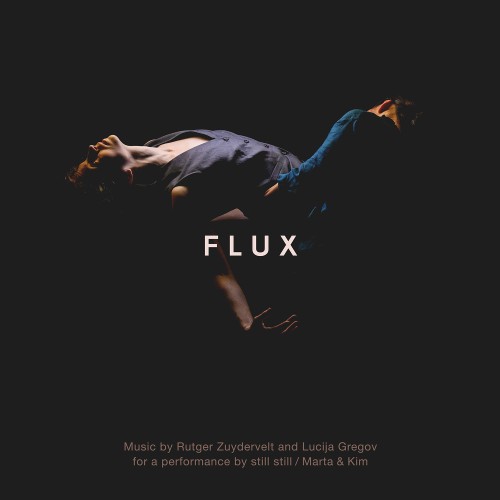Music by Rutger Zuydervelt and Lucija Gregov
for a performance by still still / Marta & Kim
1. (Not) Not Three High
2. Troyka
3. Vertigo
4. Corridors and Memories
5. Marie's Memory
6. Carry Kim
7. Lava Lamp
8. Conversation
9. Mandala
10. Spinning Dress
11. Drone (outtake)
12. Euphoria (outtake)
digital release, November 2025
Available here
When circus/dance duo Marta & Kim (Marta Alstadsæter and Kim-Jomi Fischer) asked me to compose the music for their performance FLUX, we agreed it might be nice for me to collaborate with another musician this time. I suggested inviting Lucija Gregov, with whom I play in the quartet Hydra Ensemble – a great and versatile cellist whose playing would perfectly match the concept of the performance: a delicate balance between instability and control.
Instead of writing parts for Lucija to play, I choose for a different (and more fun) approach: I sent her a bunch of 'inspirational keywords’ to improvise on. These included "a slowly tilting horizon", "falling asleep", "punctuated silence" and "Morton Feldman, but drunk". This way of working proved really fruitful. Very quickly, I received a folder full of wonderfully usable cello recordings – an amazing library of sounds to start creating the actual score with.
My preferred way of working (for dance) is to make sure there’s already some music before the performers go into rehearsal, so that from the very beginning, music and movement can start inspiring each other. With FLUX, the first tracks I built from Lucija’s recordings already totaled about 1.5 hours of music, so there was plenty of sound to work with when rehearsals started. There were revisions, of course, and additional music was created along the way, but these first musical propositions formed the building blocks of the FLUX soundtrack.
After previous shows 'Engel' and 'Our Arms Grew Together', Marta Alstadsæter changed her role to director, with Kim performing with additional dancers Marie Khatib-Shahidi and Hellen Boyko. A masterstroke, and together with the simple but spectacular light design by Loes Schakenbos, all elements come together beautifully, resulting in an emotional and powerful performance.
Rutger Zuydervelt, November 2025
Reviews
A Closer Listen
Rutger Zuydervelt has been extremely active this season, releasing a series of solo and collaborative works across multiple genres. FLUX sees the artist returning to the fruitful collaboration with the circus / dance duo Marta & Kim (Marta Alstadsæter and Kim-Jomi Fischer), but with a twist. This time Zuydervelt enlisted the aid of cellist Lucija Gregov, to whom he provided inspirational prompts (our favorite prompt: “Morton Feldman, drunk”) leading to a large file of source material. The earliest cuts went to the dance troupe, the dancers started to dance, the composer continued to compose, and FLUX was born: a living document for living dancers. The listener can sense the movement in the music; the title is well-matched to the performance, and vice versa.
The album and performance start humbly, with cracks of percussion and snippets of cello, echoing and receding. Toward the end of “(Not) Not Three High,” all of the parts awaken, sinews stretched to maximum capacity. The cello is often used as drone, and not simply in the excerpt of that name; in “Vertigo,” the drone contributes a an exploratory, wondering tone that snaps as it revolves like a spinning plate, increasing in velocity until it settles. (We’d love to see what the dancers are doing during this segment!) Moments of near-silence are inserted throughout: space for contemplation, or the pause before the shift. In “Corridors and Memories,” staccato strings signal an encroaching tension. “Marie’s Memory” extends the unease with a creaking door and filtered laughter. “Lava Lamp” restores a sense of peace, an aural reflection of its name.
“Mandala” is the album peak, the track to which the entire set builds. But one doesn’t hear it coming, as it rises directly from the long, sedate “Conversation.” The early part of the piece is fraught with yearning, the latter part with triumph. The mandala represents the universe, and in his selection of Gregov’s cello lines, Zuydervelt makes the album’s musical universe expand. As the percussion enters, it contributes a ritualistic, spiritual aspect. And then the brass, surprising and welcome, offering a transcendent fanfare, followed by a brief electronic denouement. One can imagine the lights sparkling, the dancers lifting their hands, the audience rising to its feet.
A circus expands the imagination, daring attendees to dream. When one thinks of circus music, one likely pictures a template that was once exciting, but has since fallen into cliché. Zuydervelt and Gregov’s original score for FLUX is as unpredictable as that first circus, rolling into a wagon town, restoring a sense of wonder to dancer and audience alike.
